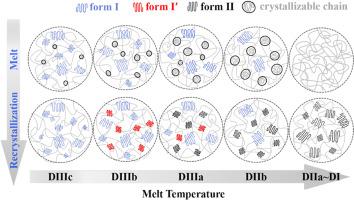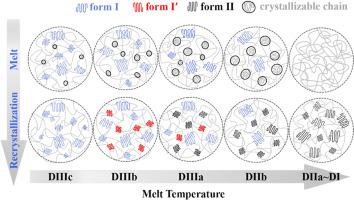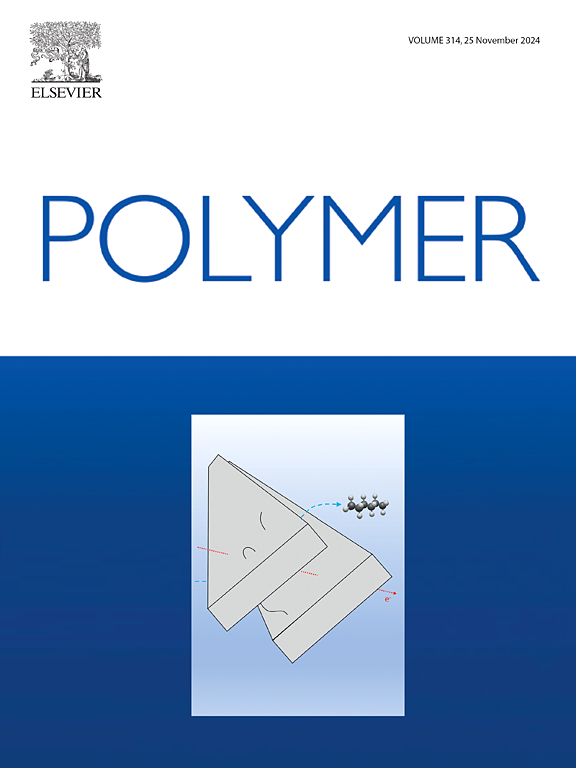Investigation on the polymorph selection during recrystallization of isotactic Polybutene-1 homopolymer
IF 4.5
2区 化学
Q2 POLYMER SCIENCE
引用次数: 0
Abstract
The influence of melt structure on the polymorphic selection during recrystallization of isotactic polybutene-1 (iPB-1) was investigated with differential scanning calorimetry (DSC) and wide-angle X-ray diffraction (WAXD) measurements in this work. The melt with varying ordered structures was prepared by controlling the melt temperature (Tme). The result revealed a significant memory effect on the polymorphic selection in recrystallization, which recrystallized into form I′ or II depending on Tme and the initial crystallization temperature of the sample. The Tme range, which was commonly divided into three Domains (Domains I, II, and III) according to the recognized rule, was re-divided. Where the Domain III was further divided into three regions while Domain II was further divided into two regions based on the melting of initial form I and the polymorphic selection in recrystallization. To be specific, only the initial crystal form I is observed in Domain IIIc; form I′ generated in Domain IIIb; while in Domain IIIa, a mixture of forms I′ and II formed; when Tme reaches Domain IIb, the melt crystallize into form II while no formation of form I′ is observed; in Domain IIa, where only form II is shown, the initial crystal form I is not observed. Samples with different initial crystallization temperatures exhibit significant variations in the specific boundary temperatures of Domains, which may be attributed to the lamellar thickness and its distribution in the initial crystals. Overall, the polymorph selection is attributed to the heterogeneous melting of the initial lamellae.


等规聚丁烯-1均聚物重结晶过程中形貌选择的研究
采用差示扫描量热法(DSC)和广角x射线衍射(WAXD)研究了熔体结构对等规聚丁烯-1 (iPB-1)重结晶过程中多晶选择的影响。通过控制熔体温度(Tme),制备了具有不同有序结构的熔体。结果表明,在再结晶过程中,多晶选择具有显著的记忆效应,根据时间和初始结晶温度的不同,再结晶形成I′型或II型。根据识别的规则,将Tme范围重新划分为三个域(域I、域II、域III)。其中,基于初始形态I的熔化和再结晶过程中的多态选择,将Domain III进一步划分为3个区域,Domain II进一步划分为2个区域。具体来说,在IIIc畴中只观察到初始晶型I;在领域IIIb中生成的表格I;而在结构域IIIa中,形成了形式I'和II的混合物;当Tme达到IIb区域时,熔体结晶为II型,未形成I'型;在IIa畴中,只有II型存在,没有观察到初始晶型I。不同初始晶化温度的样品在畴的特定边界温度上表现出显著的差异,这可能与初始晶层厚度及其分布有关。总的来说,多晶选择归因于初始薄片的非均匀熔化。
本文章由计算机程序翻译,如有差异,请以英文原文为准。
求助全文
约1分钟内获得全文
求助全文
来源期刊

Polymer
化学-高分子科学
CiteScore
7.90
自引率
8.70%
发文量
959
审稿时长
32 days
期刊介绍:
Polymer is an interdisciplinary journal dedicated to publishing innovative and significant advances in Polymer Physics, Chemistry and Technology. We welcome submissions on polymer hybrids, nanocomposites, characterisation and self-assembly. Polymer also publishes work on the technological application of polymers in energy and optoelectronics.
The main scope is covered but not limited to the following core areas:
Polymer Materials
Nanocomposites and hybrid nanomaterials
Polymer blends, films, fibres, networks and porous materials
Physical Characterization
Characterisation, modelling and simulation* of molecular and materials properties in bulk, solution, and thin films
Polymer Engineering
Advanced multiscale processing methods
Polymer Synthesis, Modification and Self-assembly
Including designer polymer architectures, mechanisms and kinetics, and supramolecular polymerization
Technological Applications
Polymers for energy generation and storage
Polymer membranes for separation technology
Polymers for opto- and microelectronics.
 求助内容:
求助内容: 应助结果提醒方式:
应助结果提醒方式:


